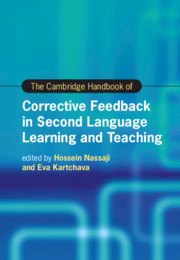Book contents
- The Cambridge Handbook of Corrective Feedback in Second Language Learning and Teaching
- Cambridge Handbooks in Language and Linguistics
- The Cambridge Handbook of Corrective Feedback in Second Language Learning and Teaching
- Copyright page
- Contents
- Figures
- Tables
- Contributors
- Acknowledgments
- Introduction Corrective Feedback in Second Language Teaching and Learning
- Part I Theoretical Perspectives on Corrective Feedback
- Part II Methodological Approaches in the Study of Corrective Feedback
- Part III Different Delivery Modes of Corrective Feedback
- 9 Oral Corrective Feedback
- 10 Written Corrective Feedback
- 11 Technology-Mediated Corrective Feedback
- 12 Gestures, Corrective Feedback, and Second Language Development
- Part IV Feedback Provider, Feedback Intensity, and Feedback Timing
- Part V Corrective Feedback and Language Skills
- Part VI Contexts of Corrective Feedback and Their Effects
- Part VII Learners’ and Teachers’ Feedback Perspectives, Perceptions, and Preferences
- Part VIII Individual Differences, Tasks, and Other Language- and Learner-Related Factors
- Index
- References
9 - Oral Corrective Feedback
from Part III - Different Delivery Modes of Corrective Feedback
Published online by Cambridge University Press: 26 February 2021
- The Cambridge Handbook of Corrective Feedback in Second Language Learning and Teaching
- Cambridge Handbooks in Language and Linguistics
- The Cambridge Handbook of Corrective Feedback in Second Language Learning and Teaching
- Copyright page
- Contents
- Figures
- Tables
- Contributors
- Acknowledgments
- Introduction Corrective Feedback in Second Language Teaching and Learning
- Part I Theoretical Perspectives on Corrective Feedback
- Part II Methodological Approaches in the Study of Corrective Feedback
- Part III Different Delivery Modes of Corrective Feedback
- 9 Oral Corrective Feedback
- 10 Written Corrective Feedback
- 11 Technology-Mediated Corrective Feedback
- 12 Gestures, Corrective Feedback, and Second Language Development
- Part IV Feedback Provider, Feedback Intensity, and Feedback Timing
- Part V Corrective Feedback and Language Skills
- Part VI Contexts of Corrective Feedback and Their Effects
- Part VII Learners’ and Teachers’ Feedback Perspectives, Perceptions, and Preferences
- Part VIII Individual Differences, Tasks, and Other Language- and Learner-Related Factors
- Index
- References
Summary
We provide an overview of research that explains what oral corrective feedback is, how it can be expressed by teachers and peers, and how it may impact the language development process. We define oral corrective feedback as a negative evidence provided in response to learner error in an oral mode. A theoretical rationale for the role of feedback is described, drawing on research from both cognitive-interactionist and sociocultural explanations of second language learning through oral communication. Examples from numerous studies are incorporated to exemplify the range of ways feedback is provided on different types of linguistic errors. Research on the relative effectiveness of different types of feedback is reviewed, as well as empirical inquiry into the role of individual and social factors that can enhance or limit the effectiveness or oral feedback, concluding that oral corrective feedback is an important factor for language learning in instructed settings. We close with recommendations for research-driven teaching practice with respect to oral corrective feedback, cautioning that teachers need to consider learner experiences and expectations of feedback, their pedagogical objectives and approach, as well as learners developmental needs, self-monitoring skills, and ability to provide feedback to one another.
Keywords
- Type
- Chapter
- Information
- The Cambridge Handbook of Corrective Feedback in Second Language Learning and Teaching , pp. 187 - 206Publisher: Cambridge University PressPrint publication year: 2021
References
- 5
- Cited by

